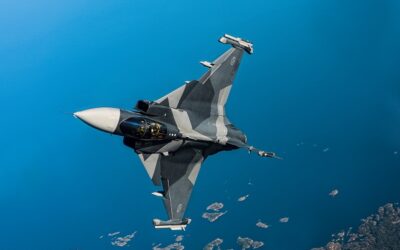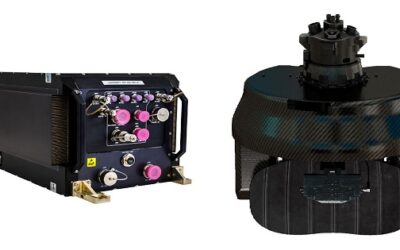Raytheon Developing New EXCALIBUR Variants
In production for over a decade, the 155mm EXCALIBUR artillery projectile has been delivered to the US Army and Marine Corps, as well as the armed forces of six other nations. Reportedly fired over 1,400 times in combat, it is defined as a ‘precise weapon,’ typically hitting less than 2m from the target.
Since fielding EXCALIBUR Ib, the latest variant, in 2014, the Army and Raytheon Missile Systems have been developing new incarnations to meet domestic and international customer requirements: a proprietary labeled ‘Hit-to-Kill’ (HTK) round to compete for the US Army’s Cannon-Delivered Area Effects Munition (C-DAEM) Increment 1 programme; an ‘S’ version (with GPS and a semi-active laser seeker); and the ‘N5’ variant for the 5in naval gun.
Paul Daniels from the company’s International and Growth Programs team, notes that the HTK solution is a response to the Army’s requirements “to defeat poorly located, moving or relocated targets at extended ranges in a contested GPS environment.” He added that, to meet these requirements, which are formally part of the C-DAEM Increment 1 contract, Raytheon is now evolving subsystems of HTK. “What we decided to do, is develop an armor-penetrating (AP) payload defeat mechanism. As opposed to a laser-guided weapon, we wanted a solution with an autonomous capability. This frees up designators and other assets, and the weapon will find, detect, discriminate and lock on to the target and be guided to the target. This is what the Army has keyed in on [it is an] autonomous seeker capability, with the projectile actually striking the target and defeating it with the AP payload – thus, the HTK name.”
If it remains successful in the C-DAEM effort, “this will be the first time any artillery force in the world will have such capability,” Daniels pointed out. A follow-on C-DAEM contract, expected later this year, will require HTK projectiles for a demonstration which, according to Army budget documents, will occur in 2021 on current howitzers and the new Extended Range Cannon Artillery gun. Another return on investment the Army is seeking from both EXCALIBUR Ib and HTK, is to achieve a 70km range against the earlier defined target sets. “EXCALIBUR is the perfect platform for that mission. With several successful tests reaching well beyond 60km, we are on a path to reach 70km from the Army’s ERCA system,” Daniels stated.
In February, Raytheon announced the successful testing of EXCALIBUR S by the US Navy. This regimen proved the projectile can survive the shock, stress and rigoor of being fired from a howitzer, then transition from a GPS-guided capability to laser guidance and hit a moving target. “That again demonstrated the company’s ability to ‘put these things together’, hit a target that was moving, and become a whole lot more confident we can do what we need to for HTK,” Daniels explained.
Trevor Dunwell, Raytheon’s EXCALIBUR Programme Director, highlighted the expanded target sets the S version will provide operators – including not only individual vehicles, but specific vehicles in convoys. He noted that in addition to bringing users innovation and quality, Raytheon is also committed to remaining “on the leading edge of the projectile market and what we are doing. When you consider what we’re doing with EXCALIBUR beyond Ib, it is taking extended-range precision artillery to a new level. We are reshaping the battlefield.”
“EXCALIBUR [is] a platform for growth,” Daniels emphasized, adding it is a purpose-built, precision, extended-range projectile “with the modularity, the space and power to really test your imagination in terms of different payloads and different seeker technology. GPS jamming and spoofing has been a real concern for the US Army. We have been working closely with them on this in the last few years and have the most robust protection of any cannon-fired weapon in the world. Nobody can match us. It’s because we have this platform with which we can work and adapt.”
The Army also required a capability to engage hard-to-reach targets – positioned on reverse slopes or under bridges, for example. To that end, Raytheon was tasked by the Army to develop an Enhanced Shaped Trajectory (EST) capability, allowing operators to programme the projectile’s terminal angle of attack and angle of fall. The company developed and demonstrated EST within six months.
In September 2018, Raytheon successfully completed its latest round of N5 version testing for the US Navy and continues to develop this baseline technology. Raytheon pointed out that Army investment in seeker technology and protection against threats to GPS navigation can be leveraged by US and international naval customers, due to the commonality of the projectiles’ electronics and software.
Marty Kauchak

























